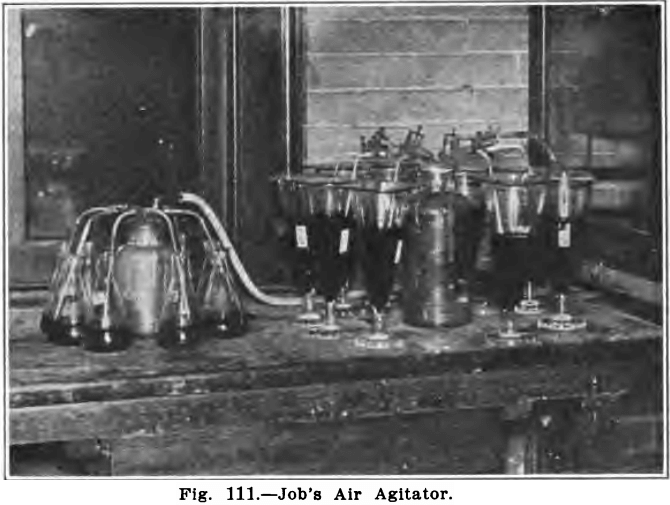Measuring Apparatus.—The chief forms of these are burettes, pipettes, graduated flasks, graduated cylinders and “graduates.” Burettes have already been described, and an automatic pipette was also mentioned, both in Chapter VII.
For roughly measuring reagents, graduated cylinders are usually used. These may be obtained in sizes ranging from 5 cc. to several liters. A convenient form is manufactured by Whitall, Tatum & Co., in which the foot is made very heavy in order to make the cylinder less liable to turn over. Cylinders can be obtained with double graduations and also with ground glass stoppers. The latter form are handy for making up dilute acids and solutions in which two liquids are used.
For accurately delivering small volumes of solutions, pipettes are used. These are made in sizes ranging from 5 to 100 cc. and are filled, to a given mark on the stem above the bulb, with the liquid by suction and then allowed to empty and drain themselves. Graduated pipettes, which are practically nothing but small burettes, the flow out of which is controlled by the finger on the upper end, can also be obtained and with these any volume can be delivered. They are made as small as 1 cc., graduated into 1/100 cc. and as large as 50 cc., graduated into 1/10 cc. Special pipettes are also made. Some bulb pipettes are made to deliver a certain volume between a mark on the upper stem and one on the lower. Pipettes are usually marked to show at which temperature the given volume is delivered.
Graduated flasks or “Volumetric Flasks” are usually made to hold a certain volume when filled to a given mark on the neck, although they can be obtained with two marks, the lower of which denotes the volume contained and the upper the volume delivered. Flasks for volumetric work should preferably have ground glass stoppers. The sizes kept in stock by dealers in chemical glassware are from 25 cc. to 2 liters.
Measuring apparatus may now be obtained accompanied by certificates of the U. S. Bureau of Standards as to correct volume, or it may be sent to them for verification.
Motors.—For laboratory purposes electric and water motors will be found most convenient for furnishing power. A small H.P. motor will run almost any piece of machinery about an analytical laboratory and these may be purchased for between $40.00 and $50.00, wound for 110-volt or 220-volt circuit. For running crushing and grinding machinery, a 1 H.P. motor will usually be sufficient and this can be obtained for about $75.00. For running, a few stirrers, rotating anodes, etc., a No. 7 Porter motor wound either for battery ($7.00) or power ($8.00) may be used to ad-vantage, a leather shoe-string serving for a belt.
Rabe’s small water motors are also useful for running a stirrer or two. They cost $6.75 with holder to attach them to a support. Connections are made to water faucets with stout rubber tubing. Larger water motors, the power of which will of course depend on the water pressure, are obtainable, in sizes ranging from 1/10 to 4 or more horse power. If good water pressure is at hand they are cheaper than electric motors.
Where neither electricity nor gas are obtainable hot air motors may be used. They are very expensive, however, a 1/5 H. P. motor costing about $300.
Stirrers, Shakers, Etc.—A great variety of mechanical contrivances for stirring liquids are on the market, of which Fig. 109 shows one of the simplest, devised by Blair, and illustrated in his “Chemical Analysis of Iron.” It may now be purchased of dealers in chemical supplies.
A simple shaker for precipitation is Dudley’s, shown in Fig. 110, and this also is a stock article. Numerous forms of shaking devices are illustrated and described in various text books of analytical chemistry.
Mr. Robert Job described a simple method for agitating solutions by means of air blown through them. The air is first

made to bubble through water to take out the dust, etc., and is then passed into the solution through a glass tube. For dissolving steel in cupric chloride solution, Mr. Job placed the drillings in a test glass. Fig. in shows the apparatus. For phosphorous determinations Erlenmeyer flasks were used and for magnesia precipitates the author has used beakers.
Thermometers.—For ordinary purposes, chemical thermometers having a long thin stem, about ¼-inch bore, and the scale engraved on the glass, will answer. They can be obtained reading as high as 360° C., graduated into degrees, or reading to 550° C. graduated every 5 degrees. For calorimeters and such work more delicate thermometers can be obtained, while for research work in boiling and melting points Beckmann’s thermometers are used. Thermometers accompanied by certificates as to their accuracy from the Deutsche Physikalische-Technische Reischsanstalt or the U. S. Bureau of Standards can be obtained at a slightly increased cost.
Pyrometers are used for temperatures higher than 550° C. Of these Le Chatelier’s, Wanner’s, the Fery and Bristol’s are all good forms, each one of which is best suited to some particular kind of work. They are fully described in various works on metallurgy, thermochemistry, etc.
